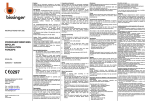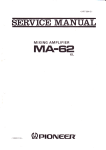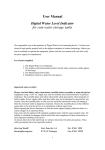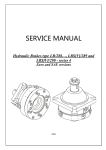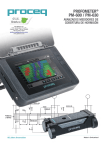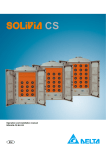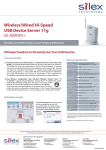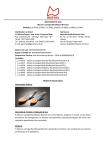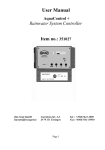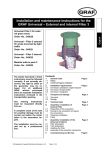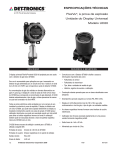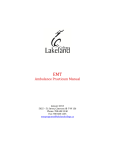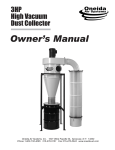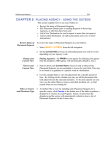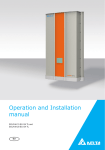Download detachable bipolar coagulation forceps
Transcript
Caution Please read all information contained in this insert. Incorrect handling and care as well as misuse can lead to premature wear of surgical instruments. Intended Use The Detachable Bipolar Coagulation Forceps is intended for use in minimally invasive and especially laparoscopic surgical procedures. The device is to be passed through a 5.5 mm laparoscopic cannula. Coagulation is achieved using electrosurgical energy under laparoscopic visualisation. This device is intended to be used with the outputs of compatible electrosurgical generators such as Erbe, Martin, Berchtold, Codman, Valleylab and comparable generators. INSTRUCTIONS FOR USE DETACHABLE BIPOLAR COAGULATION FORCEPS Article-No. 85500000 – 85588013 0297 Bissinger Medizintechnik GmbH Hans-Theisen-Str.1 79331 Teningen Germany Tel.: ++49 7641 9 14 33 0 Fax: ++49 7641 9 14 33 33 Email: [email protected] www.bissinger.com HH-855_Zerl-Zange-2009en_vG.doc Index G 09.05.2009/MB The Detachable Bipolar Coagulation Forceps is designed to manipulate, grasp or cut selected tissue. It must be connected to the bipolar output of an electrosurgical generator. As indicated bipolar coagulation current may be selectively applied to the tissue. The maximum output voltage of the generator must not exceed 500 Vp. Suitable Cables: Bissinger Bipolar Cable Art. No 855 0010x. Bissinger Adapter Art. No. 85500400, 85500401 Caution: Bipolar coagulation instruments should be used only by individuals who are trained and licensed to use such devices. Examples of such training and experience include: Training through qualified residency program, surgical skills workshops, training programs offered by equipment manufacturers or preceptorship/surgical assistant training. Caution: In particular when using parenchymal tissue may deflagrate. the scissors, Use and safety instructions All instruments have to be completely cleaned, disinfected and sterilised before initial use and any subsequent use. It is very important to check each surgical instrument for visible damage and wear, such as cracks, breaks or insulation defects before each use. In particular, areas such as blades, tips, notches, locking and blocking devices as well as all mobile parts, insulations and ceramic elements have to be checked carefully. Never use damaged instruments. Never use the instruments in the presence of flammable or explosive substances. The instrument may not be laid down on the patient. Coagulation should only be performed if the contact surfaces are visible. Do not touch any other metallic instruments during coagulation. Assembly and Operation Follow the pictrogram PIC-855 for assembly and disassembly of the instrument. Once correctly assembled and connected to power, the device may be used in either the right or the left hand. To close jaws: compress (grip) handle. To open jaws: release (grip) handle. Coagulation current is activated by a footswitch that is part of your electrosurgical unit. Reprocessing Due to the product design, the raw materials used and the intended purpose it is not possible to determine a precise limit with regard to the maximum possible number of reprocessing cycles. The serviceable life of the instruments is determined by their function as well as by a careful handling. Instruments for electrosurgery are by nature subject to increased wear depending on the type and time of use. Preparation and transport Remove coarse dirt from the instruments immediately after each use. Do not use fixation agents or hot water (>40°C/104°F) as this may result in the fixation of residues and could reduce the cleaning success. Storage and transport of the instruments to the reprocessing location must be ensured in a sealed container to avoid any damage to the instruments and any contamination of the environment. Manual Pre-Cleaning Immerse the instrument in cold water for 5 minutes. Brush the instruments under cold water until all visible impurities are removed. Then disassemble the instrument and brush again as before. All internal cavities, threats and holes must be flushed with the water pistol for 10 seconds and then rinsed and brushed again. Ultrasonic Pre-Cleaning The instrument must be disassembled and inserted in an ultrasonic bath with 0.5% alkaline cleaning detergent. Ultrasound must be applied for 15 minutes at 40°C/104°F. Machine reprocessing Cleaning Place the instruments in a basket on the insert module or on the inserts of the MIS module and start the cleaning process. 1. Prerinse for 1 min. with cold water 2. Discharging 3. Prerinse for 3 min. with cold water 4. Discharging 5. Wash for 5 min. at 55°C/131°F with a 0.5% alkaline or at 45°C/113°F with an enzymatic cleaning agent. 6. Discharging 7. Neutralise for 3 min. with warm tap water (>40°C/104°F) and a neutralising agent. 8. Discharging 9. Rinse 2 min. with warm tap water (>40°C/104°F). 10. Discharging Disinfection Machine operated thermal disinfection has to be carried out in consideration of the national requirements with regard to the A0 value (see ISO 15883). Drying Dry the outside of the instruments by carrying out a drying cycle of the cleaning/disinfection machine. If necessary, manual drying may additionally be carried out using a lint free cloth. Dry all cavities of the instruments by blowing with sterile compressed air. Manual reprocessing Cleaning Prepare a cleaning bath according to the manufacturer's instructions. 1. Rinse products with cold tap water (<40°C/104°F) until all visible accumulations of dirt have been removed. Remove stuck dirt by using a soft brush. 2. Place products in the prepared cleaning bath so that they are completely submersed. Observe residence time according to the manufacturer's instructions. 3. Clean the instrument in the bath manually using a soft brush. All surfaces have to be brushed several times. 4. The following steps only apply to channels and the insides of tubes: The brush has to be pushed in and out of the tubes at least six times. Rinse the tubes with distilled water and repeat the procedure. 5. Rinse the products thoroughly with running tap water to remove the cleaning agents without residue. Disinfection Prepare a disinfectant bath according to the instructions of the disinfectant manufacturer. Place the instruments in the disinfectant bath and observe the specified residence time. Rinse the products thoroughly with fully demineralised water to remove the disinfectant without residue. Drying Manual drying is carried out using a lintfree cloth and, in particular, for drying cavities and channels, sterile compressed air. Functional test and packaging Perform visual inspection for cleanliness; if required, perform an assembly and functional test according to the operating instructions. If necessary, repeat the reprocessing process until the instrument is optically clean. Packaging has to comply with ISO 11607 and EN 868 standards for packaging for sterilised instruments. The surface of the non-stick electrode jaws is made from precious metal and may tarnish, similar to silver. This does not impair the functionality of the instrument. The original gloss can be established by polishing with a silver cleaning cloth. Sterilisation Sterilisation of the products with fractional pre-vacuum procedure (in accordance with ISO 13060 / ISO 17665) in consideration of the respective national requirements. - 3 pre-vacuum phases, pressure at least 60 mbar - Heating up to a sterilisation temperature of min. 132°C/270°F and max. 137°C/278°F - Shortest exposure time: 3 min. - Drying time: at least 10 min. Storage Sterilised instruments have to be stored in a dry, clean and dust-free area at moderate temperatures from 5°C to 40°C. Repairs Never attempt to perform repairs yourself. Service and repair work may only be performed by persons qualified and trained accordingly. For any question on these matters, please contact either the manufacturer or your medical-technical department. Attention: Defect products must pass the complete reprocessing process before being returned for repair. Handling During transport, cleaning, care, sterilisation and storage, all surgical instruments should be handled with maximum care. This applies particularly to blades, fine tips and other sensitive areas. Information about the validation of the reprocessing instructions The following testing instructions, materials and equipment have been used for validation: Cleaning agents (for machine use): Neodisher FA by Dr. Weigert (alkaline) Endozime by Ruhof (enzymatic) Cleaning agent (ultrasound) Neodisher FA by Dr. Weigert Cleaning agents (manual cleaning): Enzol Enzym, detergent by Johnson&Johnson Neutralising agent: Neodisher Z by Dr. Weigert Cleaning and disinfection device: Miele G 7736 CD Miele insert module E 327-06 Miele MIS module E 450 For details, see report. SMP GmbH # 01707011901-2 (machine cleaning) Northview Laboratories #P8H066 (manual cleaning, sterilisation) Nelson Labs # 200432706-02 (sterilisation) MDS GmbH Testbericht 084183-10 (Sterilisation) If the chemicals and machines described before are not available, the user is obliged to validate the process used. Warranty Günter Bissinger Medizintechnik GmbH exclusively supplies tested and faultless products to the customers. All our products are designed and manufactured to comply with maximum quality requirements. We refuse any liability for products which, compared to the original product, have been modified, misused or handled or used in an inexpert way. Additional information, partially applicable to US users only: Contraindications Not intended for contraceptive coagulation of the fallopian tube but may be used to achieve hemostasis following transection of the tube. Contraindications to endoscopic procedures, not necessarily bipolar coagulation include: As identified in the Manual of Endoscopy available from the American Association of Gynecologic Laparoscopists. The presence of large pelvic or pelvic-abdominal masses, hypovolemic shock and severe cardiac decompensation. Also, intestinal obstruction and marked bowel distention, increase possibility of pelvic and abdominal adhesions. A significantly elevated diaphragm contra-indicates the use of insufflation which may be necessary for proper surgical visualisation and may increase the chance of inadvertent bowel injury. Pelvic abscess, chronic pulmonary disease, diaphragmatic hernia, obesity, and septic peritonitis may exclude some patients from surgical consideration depending on severity of these conditions. Caution: Please refer to the labelling and user manual for the electrosurgical generator for additional information on contraindications on electrosurgical or laparoscopic use. Complications reported in the medical literature during laparoscopic surgical procedures include: Hemorrhage, damage to surrounding soft tissue, leakage of bile or other secretions, infection (local and systemic), bowel perforation, damage to large blood vessels and/or neurological structures, inadvertently retained instruments and death. Adverse events reported while using bipolar electrosurgical devices include: Inadvertent activation with resultant tissue damage at the wrong site and/or equipment damage. Fires involving surgical drapes and other combustible materials have been reported. Alternate current pathways resulting in burns where the patient or physician or assistant is in contact with exposed metal. Explosions caused by electrosurgical sparking in a flammable gas environment (i.e. explosive anestetic gases). Organ perforation. Sudden massive hemorrhage. Cautions & Warnings: US Federal Law restricts this device to sale by or on the order of a physician only. Special safety precautions should be observed when using electrosurgical instruments. Electrosurgical instruments can pose a significant shock, burn or explosion hazard if used improperly, incorrectly or carelessly. - Avoid touching or grounding electrosurgical instruments to noninsulated instruments, scopes, trocar sleeves, etc. All persons using such devices should be knowledgeable in the use and handling of laparoscopic instruments, coagulation equipment, their accessories and other related equipment. - Do not use electrosurgical instruments on patients with pacemakers. - Do not use in presence of flammable liquids or anaesthetics. - Electrosurgical generators used with these devices are designed to cause destruction of tissue and are inherently dangerous if operated improperly. Follow all safety precautions and instructions supplied by the manufacturer of the electrosurgical generator. - The electrode tip must always be in full view before activating power. Apply power only when electrode tip is in full contact with the tissue selected for coagulation. Electrode tip must not come in contact with the laparoscope or other metal instruments during use. Failure to observe these cautions and contraindications may result in injury, malfunction or other unanticipated occurrences or events for the operator, staff and/or the patient. www.bissinger.com GÜNTER BISSINGER MEDIZINTECHNIK GMBH gGMBHGMBH ZERLEGBARE BIPOLARE KOAGULATIONSZANGE / DETACHABLE BIPOLAR COAGULATION FORCEPS MONTAGE / ASSEMBLY 3) PRESS 1) KLICK 2) 4) DEMONTAGE / DISASSEMBLY PIC-855_Zerlegbare bipolare Koagulationszange Stand B geändert am: 03.09.2009/MEH


